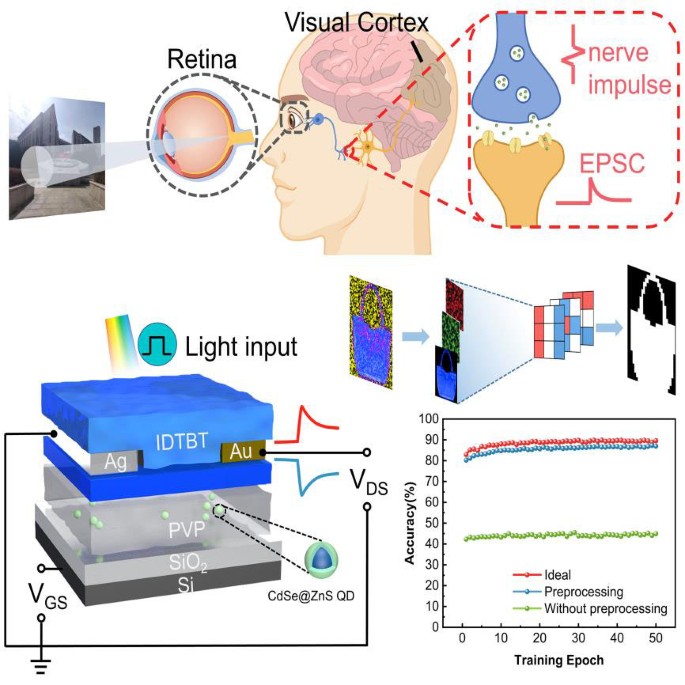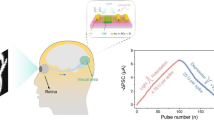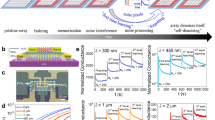Abstract
Photoelectric synaptic transistors integrate optical sensing and synaptic functions into a single device, which has significant advantages in neuromorphic computing for visual information, recognition, memory, and processing. However, the weight updating of existing photoelectric synapses is predominantly based on separate utilization of light and electrical stimuli to regulate synaptic excitation and inhibition. This approach significantly restricts the processing speed and application scenarios of devices. In this work, we propose bipolar synaptic organic/inorganic heterojunction transistor (BSOIHT) that can effectively simulate bidirectional (excitatory/inhibitory) synaptic behavior under light stimulation. Furthermore, by changing the position of electrode contacts and the metals of source and drain electrodes, carrier injection of the transistor is significantly improved with reduced synaptic event power consumption down to 2.4 fJ. Moreover, the BSOIHTs are adopted to build the neuromorphic vision system, which effectively facilitates image preprocessing and substantially enhances the recognition accuracy from 44.93% to 87.01%. This paper provides new avenues for the construction of energy-efficient artificial vision systems.
摘要
光电突触晶体管将光传感和突触功能集成到单个器件中, 在视觉信息采集、识别、记忆和处理的神经形态计算具有显著的优势. 然而, 现有光电突触的权重更新主要是基于光刺激和电刺激分别调节突触的兴奋和抑制. 这种方式严重限制了器件的处理速度和应用场景. 在这项工作中, 我们提出了双极突触有机/无机异质结晶体管(BSOIHT),可以有效地模拟光刺激下的双向(兴奋/抑制)突触行为. 此外, 通过优化电极接触位置以及电极材料, 晶体管的载流子注入得到了显著改善, 使得突触事件功耗降至2.4 fJ. 此外, 采用BSOIHT构建的神经形态视觉系统, 有效地促进了图像预处理, 将识别准确率从44.93%大幅提高到87.01%. 这为构建低能耗的人工视觉系统提供了新的途径.

Similar content being viewed by others
References
Merolla PA, Arthur JV, Alvarez-Icaza R, et al. A million spiking-neuron integrated circuit with a scalable communication network and interface. Science, 2014, 345: 668–673
Zhang X, Wu S, Yu R, et al. Programmable neuronal-synaptic transistors based on 2D MXene for a high-efficiency neuromorphic hardware network. Matter, 2022, 5: 3023–3040
Liu Y, Yang W, Yan Y, et al. Self-powered high-sensitivity sensory memory actuated by triboelectric sensory receptor for real-time neuromorphic computing. Nano Energy, 2020, 75: 104930
Guo P, Jia M, Guo D, et al. Retina-inspired in-sensor broadband image preprocessing for accurate recognition via the flexophototronic effect. Matter, 2023, 6: 537–553
Zhang Z, Wang S, Liu C, et al. All-in-one two-dimensional retinomorphic hardware device for motion detection and recognition. Nat Nanotechnol, 2022, 17: 27–32
Li H, Jiang X, Ye W, et al. Fully photon modulated heterostructure for neuromorphic computing. Nano Energy, 2019, 65: 104000
Matthews BHC. Sensory mechanisms of the retina. Nature, 1949, 163: 423–424
Dang B, Liu K, Wu X, et al. One-phototransistor-one-memristor array with high-linearity light-tunable weight for optic neuromorphic computing. Adv Mater, 2023, 35: 2204844
Lv Z, Chen M, Qian F, et al. Mimicking neuroplasticity in a hybrid biopolymer transistor by dual modes modulation. Adv Funct Mater, 2019, 29: 1902374
Shan L, Chen Q, Yu R, et al. A sensory memory processing system with multi-wavelength synaptic-polychromatic light emission for multimodal information recognition. Nat Commun, 2023, 14: 2648
Tao L, Jiang B, Ma S, et al. 3D trigonal FAPbI3-based multilevel resistive switching nonvolatile memory for artificial neural synapse. SmartMat, 2023, e1233
Jörntell H, Hansel C. Synaptic memories upside down: Bidirectional plasticity at cerebellar parallel fiber-purkinje cell synapses. Neuron, 2006, 52: 227–238
Zhu X, Gao C, Ren Y, et al. High-contrast bidirectional optoelectronic synapses based on 2D molecular crystal heterojunctions for motion detection. Adv Mater, 2023, 35: 2301468
Geiger M, Petrini L, Wyart M. Landscape and training regimes in deep learning. Phys Rep, 2021, 924: 1–18
LeCun Y, Bengio Y, Hinton G. Deep learning. Nature, 2015, 521: 436–444
Chen Y, Kang Y, Hao H, et al. All two-dimensional integration-type optoelectronic synapse mimicking visual attention mechanism for multi-target recognition. Adv Funct Mater, 2023, 33: 2209781
Zhang J, Guo Z, Sun T, et al. Energy-efficient organic photoelectric synaptic transistors with environment-friendly CuInSe2 quantum dots for broadband neuromorphic computing. SmartMat, 2023, n/a: e1246
Zhu C, Liu H, Wang W, et al. Optical synaptic devices with ultra-low power consumption for neuromorphic computing. Light Sci Appl, 2022, 11: 337
Ji R, Feng G, Jiang C, et al. Fully light-modulated organic artificial synapse with the assistance of ferroelectric polarization. Adv Elect Mater, 2022, 8: 2101402
Kwon SM, Kwak JY, Song S, et al. Large-area pixelized optoelectronic neuromorphic devices with multispectral light-modulated bidirectional synaptic circuits. Adv Mater, 2021, 33: 2105017
Shan X, Zhao C, Wang X, et al. Plasmonic optoelectronic memristor enabling fully light-modulated synaptic plasticity for neuromorphic vision. Adv Sci, 2022, 9: 2104632
Wu R, Liu X, Yuan Y, et al. Biomimetic artificial tetrachromatic photoreceptors based on fully light-controlled 2D transistors. Adv Funct Mater, 2023, 33: 2305677
Hou YX, Li Y, Zhang ZC, et al. Large-scale and flexible optical synapses for neuromorphic computing and integrated visible information sensing memory processing. ACS Nano, 2021, 15: 1497–1508
Yang CM, Chen TC, Verma D, et al. Bidirectional all-optical synapses based on a 2D Bi2O2Se/graphene hybrid structure for multifunctional optoelectronics. Adv Funct Mater, 2020, 30: 2001598
Li X, Yu B, Wang B, et al. Complementary photo-synapses based on light-stimulated porphyrin-coated silicon nanowires field-effect transistors (LPSNFET). Small, 2021, 17: 2101434
Xie P, Chen X, Zeng Z, et al. Artificial visual systems with tunable photoconductivity based on organic molecule-nanowire heterojunctions. Adv Funct Mater, 2023, 33: 2209091
Zhang Q, Li E, Wang Y, et al. Ultralow-power vertical transistors for multilevel decoding modes. Adv Mater, 2023, 35: 2208600
Venkateshvaran D, Nikolka M, Sadhanala A, et al. Approaching disorder-free transport in high-mobility conjugated polymers. Nature, 2014, 515: 384–388
Liu T, Zhang X, Zhang J, et al. Interface study of ITO/ZnO and ITO/SnO2 complex transparent conductive layers and their effect on CdTe solar cells. Int J Photoenergy, 2013, 2013: 1–8
Li E, Gao C, Yu R, et al. MXene based saturation organic vertical photoelectric transistors with low subthreshold swing. Nat Commun, 2022, 13: 2898
Lillicrap TP, Santoro A, Marris L, et al. Backpropagation and the brain. Nat Rev Neurosci, 2020, 21: 335–346
Liu Y, Liu D, Gao C, et al. Self-powered high-sensitivity all-in-one vertical tribo-transistor device for multi-sensing-memory-computing. Nat Commun, 2022, 13: 7917
Abbott LF, Regehr WG. Synaptic computation. Nature, 2004, 431: 796–803
Shan L, Zeng H, Liu Y, et al. Artificial tactile sensing system with photoelectric output for high accuracy haptic texture recognition and parallel information processing. Nano Lett, 2022, 22: 7275–7283
Yu R, He L, Gao C, et al. Programmable ferroelectric bionic vision hardware with selective attention for high-precision image classification. Nat Commun, 2022, 13: 7019
Qin S, Wang F, Liu Y, et al. A light-stimulated synaptic device based on graphene hybrid phototransistor. 2D Mater, 2017, 4: 035022
Wang Y, Lv Z, Chen J, et al. Photonic synapses based on inorganic perovskite quantum dots for neuromorphic computing. Adv Mater, 2018, 30: 1802883
Wang S, Chen C, Yu Z, et al. A MoS2/PTCDA hybrid heterojunction synapse with efficient photoelectric dual modulation and versatility. Adv Mater, 2019, 31: 1806227
Yin L, Han C, Zhang Q, et al. Synaptic silicon-nanocrystal phototransistors for neuromorphic computing. Nano Energy, 2019, 63: 103859
Park HL, Kim H, Lim D, et al. Retina-inspired carbon nitride-based photonic synapses for selective detection of UV light. Adv Mater, 2020, 32: 1906899
Zhang ZC, Li Y, Wang JJ, et al. Synthesis of wafer-scale graphdiyne/graphene heterostructure for scalable neuromorphic computing and artificial visual systems. Nano Res, 2021, 14: 4591–4600
Kim J, Song S, Kim H, et al. Light-stimulated artificial photonic synapses based on solution-processed In-Sn-Zn-O transistors for neuromorphic applications. J Alloys Compd, 2022, 903: 163873
Gupta GK, Kim IJ, Park Y, et al. Inorganic perovskite quantum dot-mediated photonic multimodal synapse. ACS Appl Mater Interfaces, 2023, 15: 18055–18064
Liang J, Yu X, Qiu J, et al. All-optically controlled artificial synapses based on light-induced adsorption and desorption for neuromorphic vision. ACS Appl Mater Interfaces, 2023, 15: 9584–9592
Mi YC, Yang CH, Shih LC, et al. All-optical-controlled excitatory and inhibitory synaptic signaling through bipolar photoresponse of an oxide-based phototransistor. Adv Opt Mater, 2023, 11: 2300089
Shao H, Li Y, Yang W, et al. A reconfigurable optoelectronic synaptic transistor with stable Zr-CsPbI3 nanocrystals for visuomorphic computing. Adv Mater, 2023, 35: 2208497
Yan Y, Yu N, Yu Z, et al. Optoelectronic synaptic memtransistor based on 2D SnSe/MoS2 van der Waals heterostructure under UV–ozone treatment. Small Methods, 2023, 7: 2201679
Gollisch T, Meister M. Eye smarter than scientists believed: Neural computations in circuits of the retina. Neuron, 2010, 65: 150–164
Pi L, Wang P, Liang SJ, et al. Broadband convolutional processing using band-alignment-tunable heterostructures. Nat Electron, 2022, 5: 248–254
Wang CY, Liang SJ, Wang S, et al. Gate-tunable van der Waals heterostructure for reconfigurable neural network vision sensor. Sci Adv, 2020, 6: eaba6173
Acknowledgements
This work was supported by the National Key Research and Development Program of China (2022YFB3603802), the National Natural Science Foundation of China (62374033), and Fujian Science & Technology Innovation Laboratory for Optoelectronic Information of China (2021ZZ129).
Author information
Authors and Affiliations
Contributions
Author contributions Chen H and Guo T conceived the project. Liu C, Gao C, and Lian M designed and performed the experiments and collected the data. Liu C, Huang W, and Xu C analyzed and discussed the data. Liu C, Chen H, and Hu W wrote the paper. All authors contributed to the general discussion.
Corresponding author
Ethics declarations
Conflict of interest The authors declare that they have no conflict of interest.
Additional information
Supplementary information Supporting data are available in the online version of the paper.
Changfei Liu received his Bachelor’s degree from Fuzhou University in 2021. Now he is a Master student of physical electronics at the School of Physics and Information Engineering, Fuzhou University. His current research interests mainly focus on the photoelectric synaptic devices.
Supporting Information
40843_2024_2812_MOESM1_ESM.pdf
Bipolar Synaptic Organic/Inorganic Heterojunction Transistor with Complementary Light Modulation and Low Power Consumption for Energy-Efficient Artificial Vision Systems
Rights and permissions
About this article
Cite this article
Liu, C., Gao, C., Huang, W. et al. Bipolar synaptic organic/inorganic heterojunction transistor with complementary light modulation and low power consumption for energy-efficient artificial vision systems. Sci. China Mater. 67, 1500–1508 (2024). https://doi.org/10.1007/s40843-024-2812-7
Received:
Accepted:
Published:
Issue Date:
DOI: https://doi.org/10.1007/s40843-024-2812-7




